Miguel D. Mahecha
Explainable Earth Surface Forecasting under Extreme Events
Oct 02, 2024



Abstract:With climate change-related extreme events on the rise, high dimensional Earth observation data presents a unique opportunity for forecasting and understanding impacts on ecosystems. This is, however, impeded by the complexity of processing, visualizing, modeling, and explaining this data. To showcase how this challenge can be met, here we train a convolutional long short-term memory-based architecture on the novel DeepExtremeCubes dataset. DeepExtremeCubes includes around 40,000 long-term Sentinel-2 minicubes (January 2016-October 2022) worldwide, along with labeled extreme events, meteorological data, vegetation land cover, and topography map, sampled from locations affected by extreme climate events and surrounding areas. When predicting future reflectances and vegetation impacts through kernel normalized difference vegetation index, the model achieved an R$^2$ score of 0.9055 in the test set. Explainable artificial intelligence was used to analyze the model's predictions during the October 2020 Central South America compound heatwave and drought event. We chose the same area exactly one year before the event as counterfactual, finding that the average temperature and surface pressure are generally the best predictors under normal conditions. In contrast, minimum anomalies of evaporation and surface latent heat flux take the lead during the event. A change of regime is also observed in the attributions before the event, which might help assess how long the event was brewing before happening. The code to replicate all experiments and figures in this paper is publicly available at https://github.com/DeepExtremes/txyXAI
Earth System Data Cubes: Avenues for advancing Earth system research
Aug 05, 2024Abstract:Recent advancements in Earth system science have been marked by the exponential increase in the availability of diverse, multivariate datasets characterised by moderate to high spatio-temporal resolutions. Earth System Data Cubes (ESDCs) have emerged as one suitable solution for transforming this flood of data into a simple yet robust data structure. ESDCs achieve this by organising data into an analysis-ready format aligned with a spatio-temporal grid, facilitating user-friendly analysis and diminishing the need for extensive technical data processing knowledge. Despite these significant benefits, the completion of the entire ESDC life cycle remains a challenging task. Obstacles are not only of a technical nature but also relate to domain-specific problems in Earth system research. There exist barriers to realising the full potential of data collections in light of novel cloud-based technologies, particularly in curating data tailored for specific application domains. These include transforming data to conform to a spatio-temporal grid with minimum distortions and managing complexities such as spatio-temporal autocorrelation issues. Addressing these challenges is pivotal for the effective application of Artificial Intelligence (AI) approaches. Furthermore, adhering to open science principles for data dissemination, reproducibility, visualisation, and reuse is crucial for fostering sustainable research. Overcoming these challenges offers a substantial opportunity to advance data-driven Earth system research, unlocking the full potential of an integrated, multidimensional view of Earth system processes. This is particularly true when such research is coupled with innovative research paradigms and technological progress.
Nonlinear spectral analysis extracts harmonics from land-atmosphere fluxes
Jul 27, 2024Abstract:Understanding the dynamics of the land-atmosphere exchange of CO$_2$ is key to advance our predictive capacities of the coupled climate-carbon feedback system. In essence, the net vegetation flux is the difference of the uptake of CO$_2$ via photosynthesis and the release of CO$_2$ via respiration, while the system is driven by periodic processes at different time-scales. The complexity of the underlying dynamics poses challenges to classical decomposition methods focused on maximizing data variance, such as singular spectrum analysis. Here, we explore whether nonlinear data-driven methods can better separate periodic patterns and their harmonics from noise and stochastic variability. We find that Nonlinear Laplacian Spectral Analysis (NLSA) outperforms the linear method and detects multiple relevant harmonics. However, these harmonics are not detected in the presence of substantial measurement irregularities. In summary, the NLSA approach can be used to both extract the seasonal cycle more accurately than linear methods, but likewise detect irregular signals resulting from irregular land-atmosphere interactions or measurement failures. Improving the detection capabilities of time-series decomposition is essential for improving land-atmosphere interactions models that should operate accurately on any time scale.
DeepExtremeCubes: Integrating Earth system spatio-temporal data for impact assessment of climate extremes
Jun 26, 2024


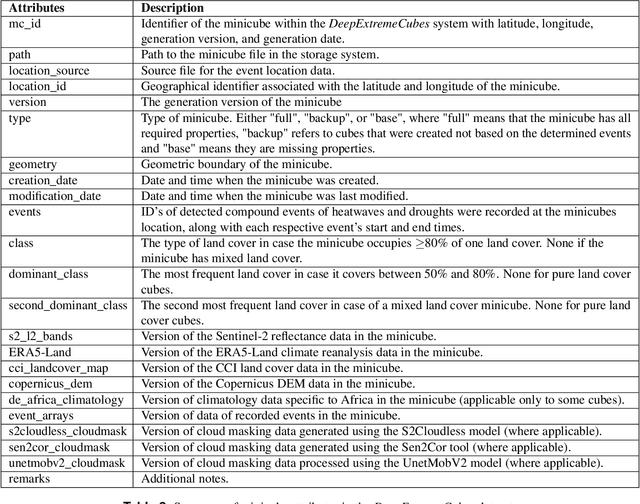
Abstract:With climate extremes' rising frequency and intensity, robust analytical tools are crucial to predict their impacts on terrestrial ecosystems. Machine learning techniques show promise but require well-structured, high-quality, and curated analysis-ready datasets. Earth observation datasets comprehensively monitor ecosystem dynamics and responses to climatic extremes, yet the data complexity can challenge the effectiveness of machine learning models. Despite recent progress in deep learning to ecosystem monitoring, there is a need for datasets specifically designed to analyse compound heatwave and drought extreme impact. Here, we introduce the DeepExtremeCubes database, tailored to map around these extremes, focusing on persistent natural vegetation. It comprises over 40,000 spatially sampled small data cubes (i.e. minicubes) globally, with a spatial coverage of 2.5 by 2.5 km. Each minicube includes (i) Sentinel-2 L2A images, (ii) ERA5-Land variables and generated extreme event cube covering 2016 to 2022, and (iii) ancillary land cover and topography maps. The paper aims to (1) streamline data accessibility, structuring, pre-processing, and enhance scientific reproducibility, and (2) facilitate biosphere dynamics forecasting in response to compound extremes.
Facilitating Advanced Sentinel-2 Analysis Through a Simplified Computation of Nadir BRDF Adjusted Reflectance
Apr 24, 2024
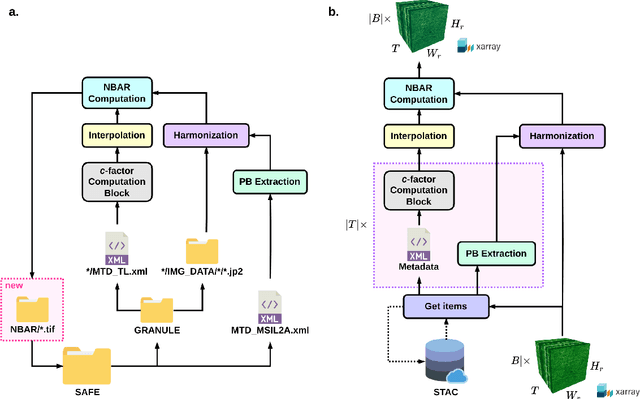

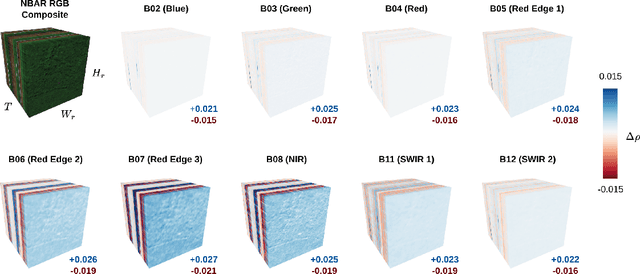
Abstract:The Sentinel-2 (S2) mission from the European Space Agency's Copernicus program provides essential data for Earth surface analysis. Its Level-2A products deliver high-to-medium resolution (10-60 m) surface reflectance (SR) data through the MultiSpectral Instrument (MSI). To enhance the accuracy and comparability of SR data, adjustments simulating a nadir viewing perspective are essential. These corrections address the anisotropic nature of SR and the variability in sun and observation angles, ensuring consistent image comparisons over time and under different conditions. The $c$-factor method, a simple yet effective algorithm, adjusts observed S2 SR by using the MODIS BRDF model to achieve Nadir BRDF Adjusted Reflectance (NBAR). Despite the straightforward application of the $c$-factor to individual images, a cohesive Python framework for its application across multiple S2 images and Earth System Data Cubes (ESDCs) from cloud-stored data has been lacking. Here we introduce sen2nbar, a Python package crafted to convert S2 SR data to NBAR, supporting both individual images and ESDCs derived from cloud-stored data. This package simplifies the conversion of S2 SR data to NBAR via a single function, organized into modules for efficient process management. By facilitating NBAR conversion for both SAFE files and ESDCs from SpatioTemporal Asset Catalogs (STAC), sen2nbar is developed as a flexible tool that can handle diverse data format requirements. We anticipate that sen2nbar will considerably contribute to the standardization and harmonization of S2 data, offering a robust solution for a diverse range of users across various applications. sen2nbar is an open-source tool available at https://github.com/ESDS-Leipzig/sen2nbar.
Recurrent Neural Networks for Modelling Gross Primary Production
Apr 19, 2024


Abstract:Accurate quantification of Gross Primary Production (GPP) is crucial for understanding terrestrial carbon dynamics. It represents the largest atmosphere-to-land CO$_2$ flux, especially significant for forests. Eddy Covariance (EC) measurements are widely used for ecosystem-scale GPP quantification but are globally sparse. In areas lacking local EC measurements, remote sensing (RS) data are typically utilised to estimate GPP after statistically relating them to in-situ data. Deep learning offers novel perspectives, and the potential of recurrent neural network architectures for estimating daily GPP remains underexplored. This study presents a comparative analysis of three architectures: Recurrent Neural Networks (RNNs), Gated Recurrent Units (GRUs), and Long-Short Term Memory (LSTMs). Our findings reveal comparable performance across all models for full-year and growing season predictions. Notably, LSTMs outperform in predicting climate-induced GPP extremes. Furthermore, our analysis highlights the importance of incorporating radiation and RS inputs (optical, temperature, and radar) for accurate GPP predictions, particularly during climate extremes.
On-Demand Earth System Data Cubes
Apr 19, 2024



Abstract:Advancements in Earth system science have seen a surge in diverse datasets. Earth System Data Cubes (ESDCs) have been introduced to efficiently handle this influx of high-dimensional data. ESDCs offer a structured, intuitive framework for data analysis, organising information within spatio-temporal grids. The structured nature of ESDCs unlocks significant opportunities for Artificial Intelligence (AI) applications. By providing well-organised data, ESDCs are ideally suited for a wide range of sophisticated AI-driven tasks. An automated framework for creating AI-focused ESDCs with minimal user input could significantly accelerate the generation of task-specific training data. Here we introduce cubo, an open-source Python tool designed for easy generation of AI-focused ESDCs. Utilising collections in SpatioTemporal Asset Catalogs (STAC) that are stored as Cloud Optimised GeoTIFFs (COGs), cubo efficiently creates ESDCs, requiring only central coordinates, spatial resolution, edge size, and time range.
ReservoirComputing.jl: An Efficient and Modular Library for Reservoir Computing Models
Apr 08, 2022


Abstract:We introduce ReservoirComputing.jl, an open source Julia library for reservoir computing models. The software offers a great number of algorithms presented in the literature, and allows to expand on them with both internal and external tools in a simple way. The implementation is highly modular, fast and comes with a comprehensive documentation, which includes reproduced experiments from literature. The code and documentation are hosted on Github under an MIT license https://github.com/SciML/ReservoirComputing.jl.
Kernel Methods and their derivatives: Concept and perspectives for the Earth system sciences
Jul 29, 2020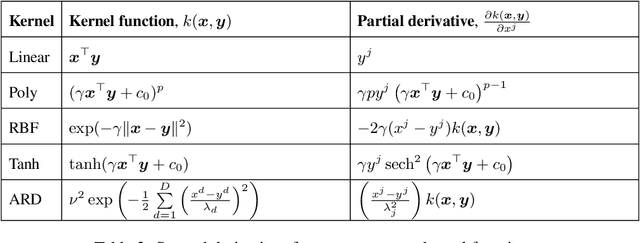
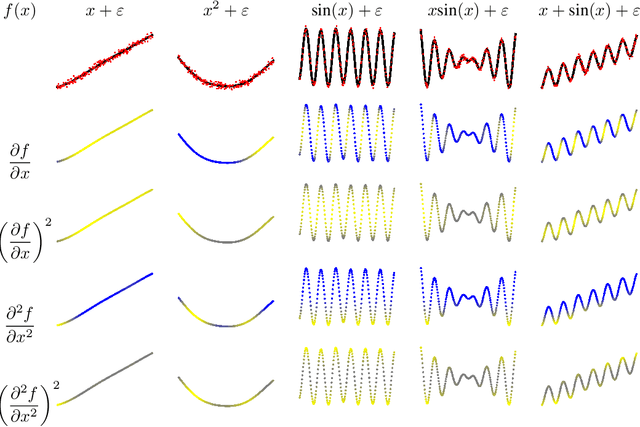
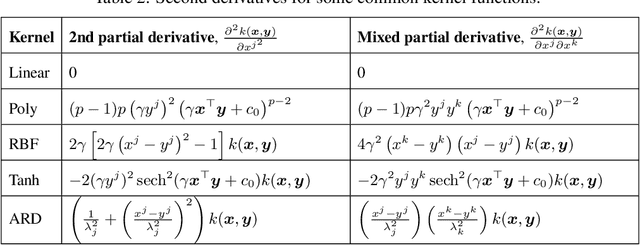
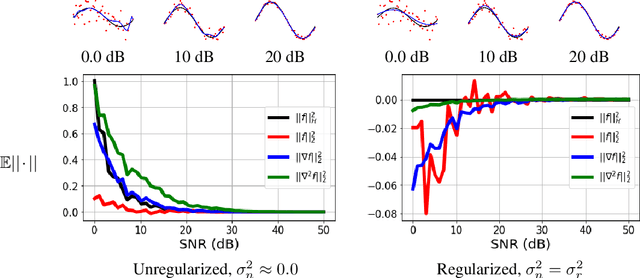
Abstract:Kernel methods are powerful machine learning techniques which implement generic non-linear functions to solve complex tasks in a simple way. They Have a solid mathematical background and exhibit excellent performance in practice. However, kernel machines are still considered black-box models as the feature mapping is not directly accessible and difficult to interpret.The aim of this work is to show that it is indeed possible to interpret the functions learned by various kernel methods is intuitive despite their complexity. Specifically, we show that derivatives of these functions have a simple mathematical formulation, are easy to compute, and can be applied to many different problems. We note that model function derivatives in kernel machines is proportional to the kernel function derivative. We provide the explicit analytic form of the first and second derivatives of the most common kernel functions with regard to the inputs as well as generic formulas to compute higher order derivatives. We use them to analyze the most used supervised and unsupervised kernel learning methods: Gaussian Processes for regression, Support Vector Machines for classification, Kernel Entropy Component Analysis for density estimation, and the Hilbert-Schmidt Independence Criterion for estimating the dependency between random variables. For all cases we expressed the derivative of the learned function as a linear combination of the kernel function derivative. Moreover we provide intuitive explanations through illustrative toy examples and show how to improve the interpretation of real applications in the context of spatiotemporal Earth system data cubes. This work reflects on the observation that function derivatives may play a crucial role in kernel methods analysis and understanding.
 Add to Chrome
Add to Chrome Add to Firefox
Add to Firefox Add to Edge
Add to Edge